Automatic learning journey enrollment
Organizations that use Knowly with SCIM can now enable automatic learning journey enrollment using dynamic lists.
What is automatic enrollment?
By using lists of users that are automatically updated based on custom filters, learning journeys in Knowly can now get their participants without admins manually adding them.
All you have to do is to create a list that corresponds to the users that you want to enroll, and connect it to the learning journey that you want them to participate in. The users are automatically added as the list gets updated.
To do this you need to use what in Knowly is called a dynamic list. A dynamic list is a list of users that is automatically updated to always contain a set of users that match some filters. You can create a dynamic list with any filters that your identity provider and Knowly supports, and then connect that list to any learning journey in your organization. Below is a guide for doing just that.
Contents
- Creating a dynamic list
- Connecting your dynamic list to a learning journey
- Participants added via dynamic lists
- Disconnecting a dynamic list from a learning journey
Creating a dynamic list
Dynamic lists are lists of users in Knowly that are automatically updated based on filters. You as a Knowly admin can create a dynamic list by visiting the user lists, reached from the menu triggered by clicking your name in the bottom left corner in the home pages.
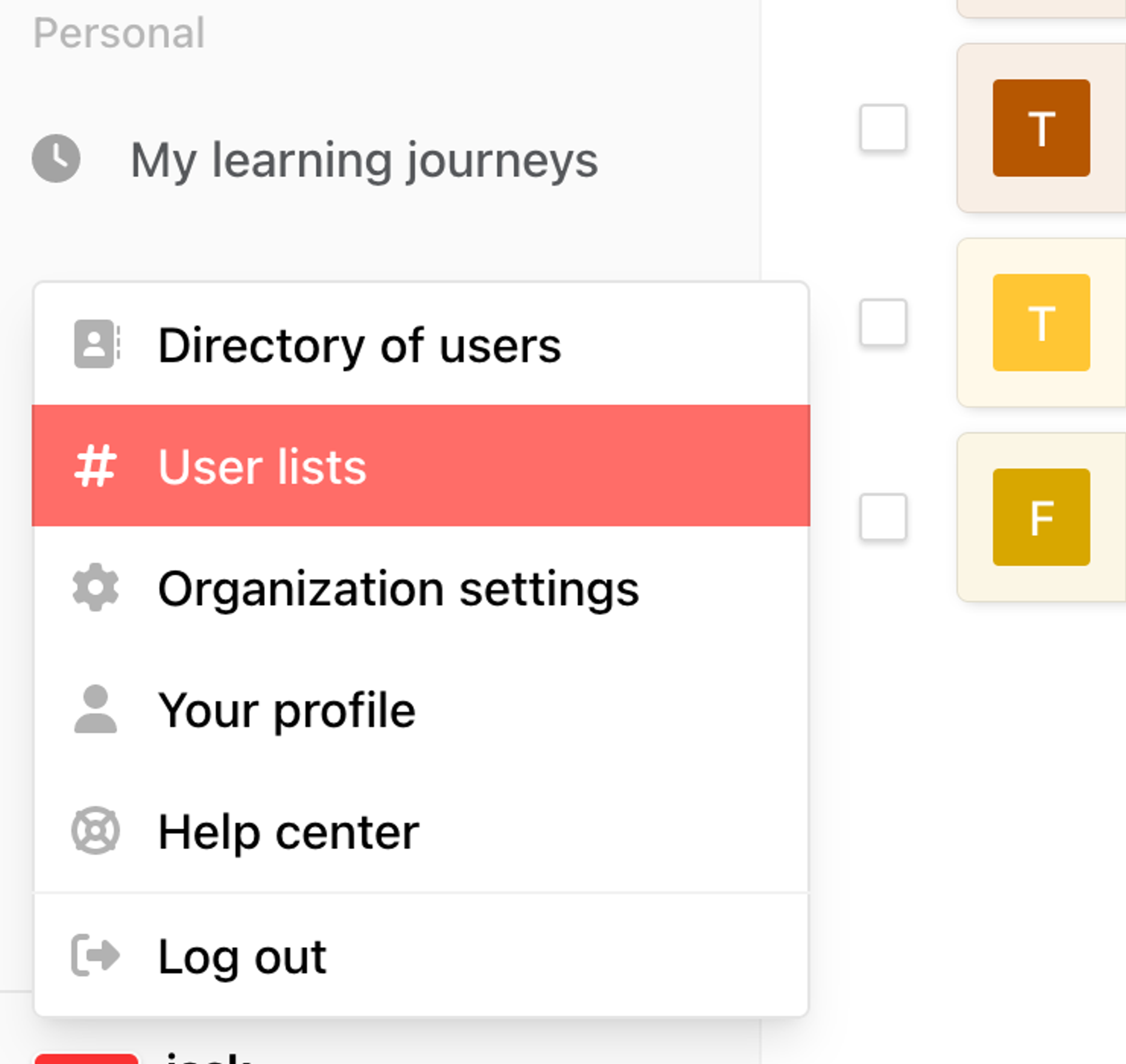
On the “Lists”-page, you can choose to create a new list by clicking the button in the top right corner.
☝ If your organization is not yet integrated with SCIM, you can only create static lists at this point.
Inside the drawer for creating a new dynamic list you will give your list a name and create the filters that decide which users will be on the list. When selecting your list for automatic enrollment, you will have to remember it by its name.
Filters in dynamic lists

The filters for dynamic lists decides who will be on the list at any given moment. When a dynamic list is created, the filters can not be changed.
The filters are made up out of four parts, below is a description of the parts as they are presented in the drawer, from left to right.
Attribute

The attributes that are provided by your organizations SCIM-connection. The attributes can be static attributes (country, department, division, etc) or dates (employment start date or Knowly user creation date). See full list below.
Relation

This defines the relation between the attribute and the value. The relation can be
- is
- is not
for static attributes and
- is
- is not
- is before
- is before or same as
- is after
- is after or same as
for date attributes.
Value

For static attributes, you can choose from all different values that are present on users that are provisioned to Knowly at the moment. For date attributes, you can choose any date.
☝ If users have no value, they are never represented, even if you choose the relation is not.
Operator

If you wish to use more than one filter, you have to decide the relation between those filters using the operator. The operator can be and, or or. If the operator is and, both filters have to be fulfilled for the users on the list. If the operator is or, one of the filters have to be fulfilled.
💡 If you want to have more complicated filters for automatic enrollment, it is possible to use more than one list per learning journey.
While you edit your filters, the list of users that currently match your filters are displayed to the right. Remember that these users can be removed later, if their corresponding values are updated, in the same way as new users will be added when their values match the filters of the list.
Full list of attributes
☝ Knowly only saves one address of the type “work” at a time.
| Attribute name | Description | Type |
| addressCountry | Country of the work address provisioned to Knowly | Static |
| addressLocality | Locality of the work address provisioned to Knowly | Static |
| addressPostalCode | Postal code of the work address provisioned to Knowly | Static |
| addressRegion | Region of the work address provisioned to Knowly | Static |
| addressStreetAddress | Street address of the work address provisioned to Knowly | Static |
| costCenterName | Cost center attribute | Static |
| departmentName | Department attribute | Static |
| divisionName | Division attribute | Static |
| employeeType | Employee type attribute (for example consultant) | Static |
| managerEmail | Manager email attribute | Static |
| employmentStartDate | Employment start date attribute that is mainly provisioned by HR systems | Date |
| createdAt | The creation date of the user in Knowly’s database, not the creation in the system that provisions the data | Date |
The attributes are auto-mapped from your identity provider via WorkOS.
☎️ If you are interested in using other attributes than these, contact Knowly support.
Connecting your dynamic list to a learning journey
When your dynamic list is set up, you are ready to connect it to a learning journey.
If your learning journey is empty, you start by clicking the “Connect dynamic list”-button on the people page in a learning journey. If your learning journey has participants already, you can find the same button under ‘Add more participants’ in the top right corner of the people page.
☝ The prerequisites for connecting a dynamic list to a learning journey is that the learning journey does not contain any group meetings and that there are no activities scheduled before the anchor date.
Connecting a dynamic list in a cohort
From here, the process is slightly different between individual- and cohort type learning journeys. We will start with start with a cohort.
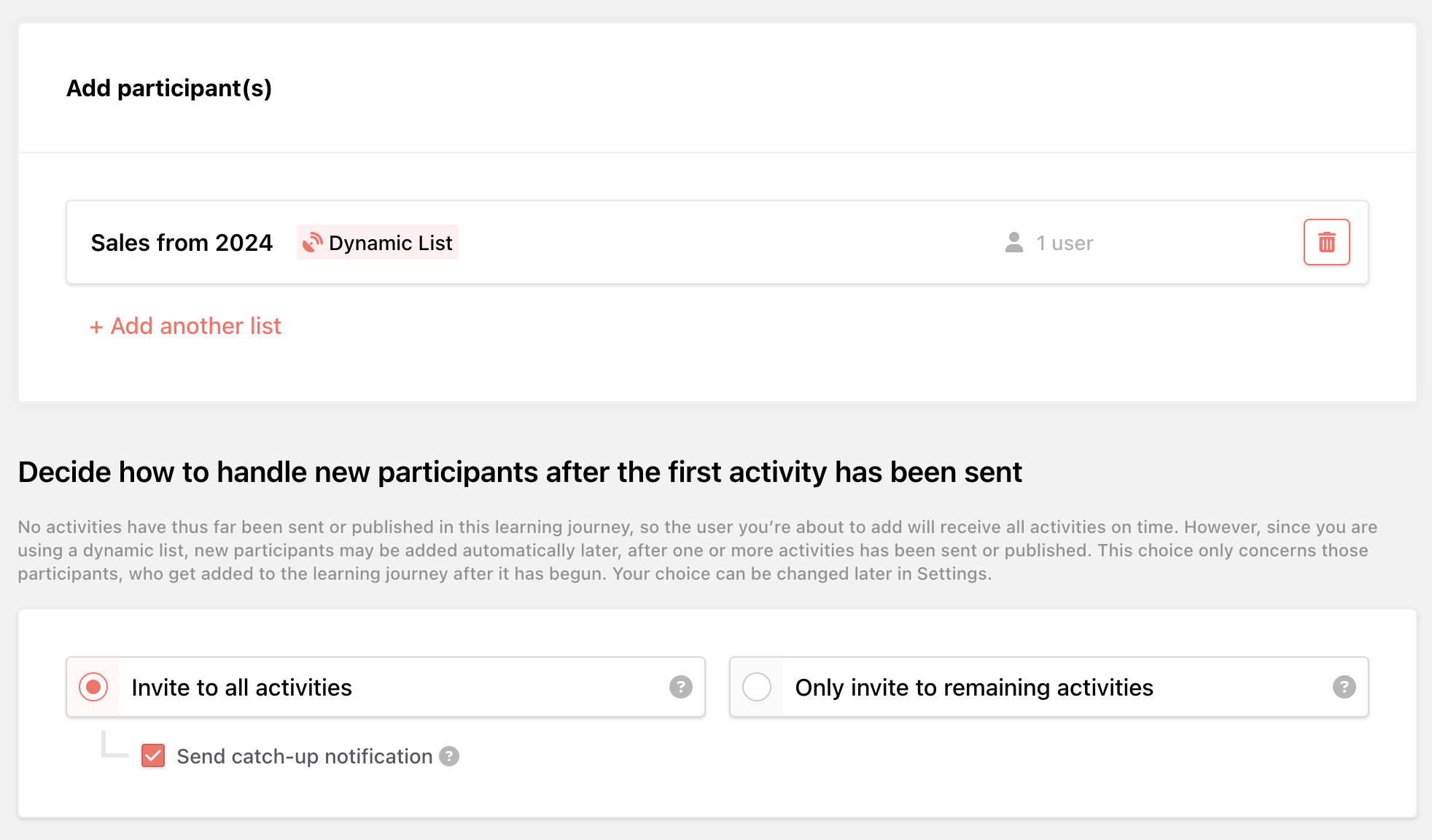
When connecting your first list(s) in a cohort, you will have to make the choice of how to handle users that are automatically enrolled after the learning journey has started. When this choice is made, it will be the same for all participants that are added via dynamic lists.
If you are connecting another list at a later occasion, you will be informed of your choice. The choice can be changed in the learning journey settings.
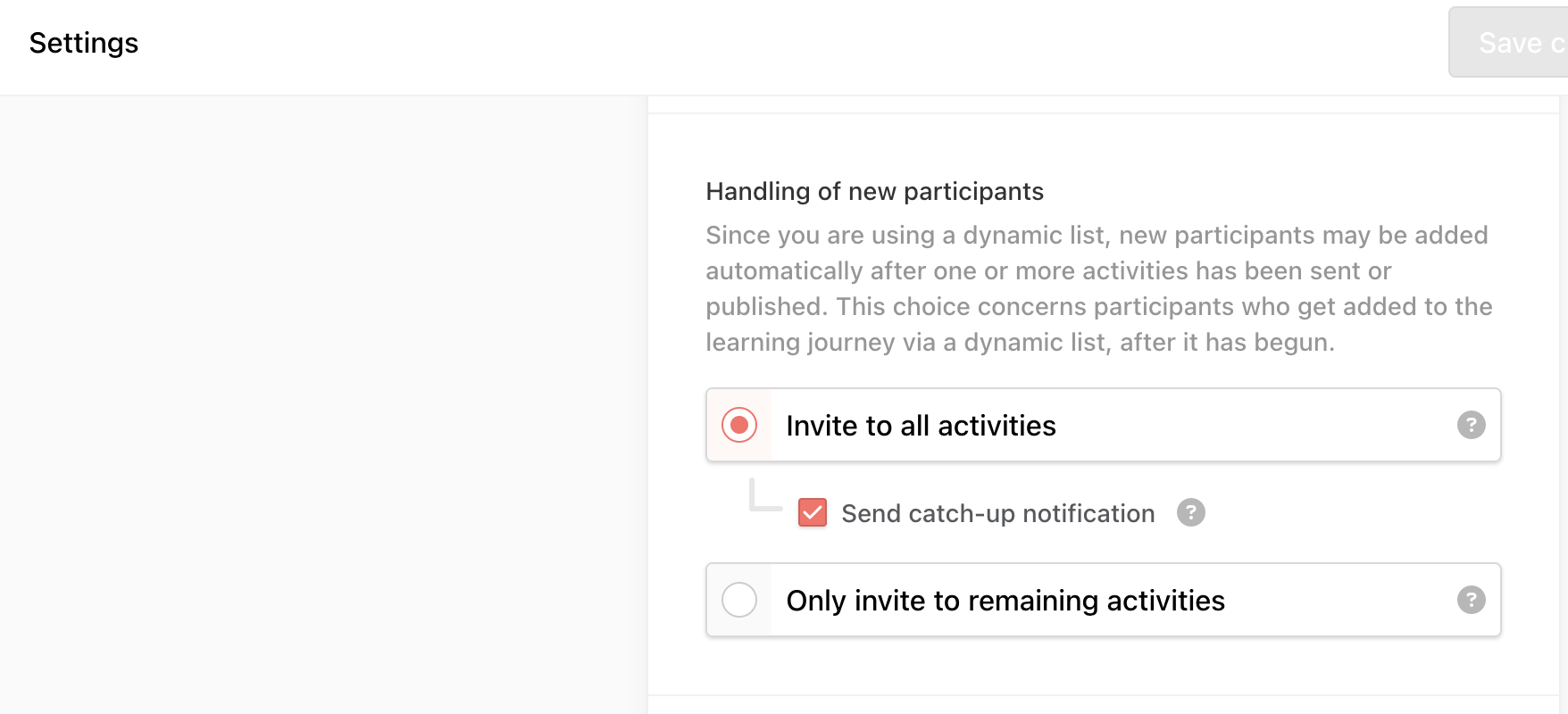
Connecting a dynamic list in an individual learning journey
In individual learning journeys, the procedure is almost the same as when you are adding participants manually. You can set the anchor date freely for the users that are on the list at the time of connecting the dynamic list.
Participants that are automatically enrolled will get the date on which they were added to the list as their anchor point.
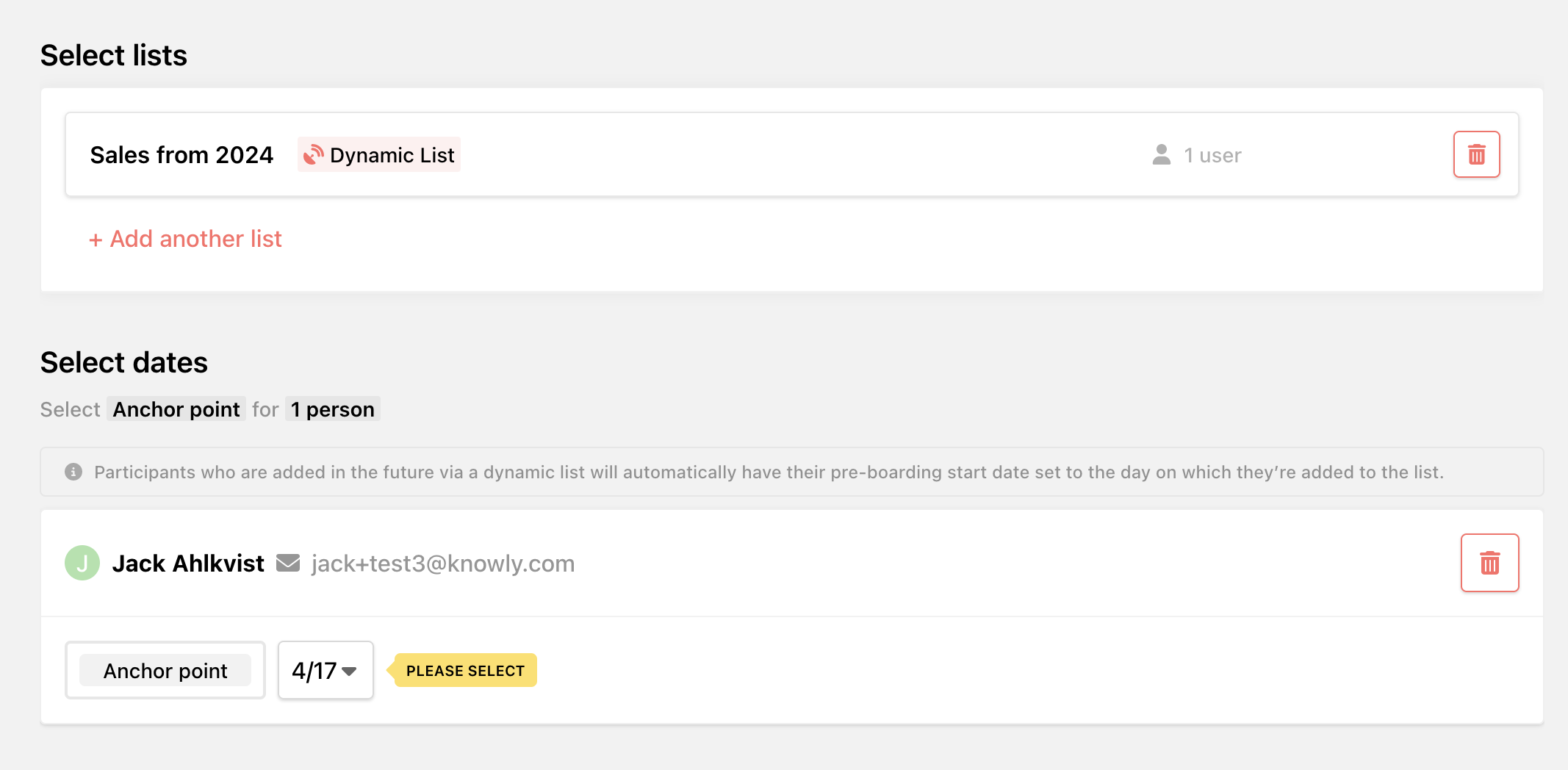
Congratulations, you have now enabled automatic enrollment of participants in Knowly! Sit back, relax, and see the users add themselves to the learning journey.
Participants added via dynamic lists
After connecting a dynamic list to a learning journey, you can see the lists that are connected on the people page. If you have more than one list, a separate page to see them is created. That page is also reachable from the people page.
💡 You can add users to your learning journey in the same way as usual, both before and after you have connected a dynamic list.
Users that have been added to a learning journey via a dynamic list have a special icon to their name in the list of participants. This also means that they can be removed from the learning journey, including all their data, if an update removes them from the list.

Good to know
- A participant can be added via more than one dynamic list, this does not change its status.
- If they are removed from one list while still on another, their participation in the learning journey will not be affected.
- Users that have been added via a dynamic list can be manually deleted from the learning journey. If you manually delete a user that has been automatically enrolled, they will not be able to be automatically enrolled again, from any list that is or will be connected. The only way to add that user to the learning journey is to do it manually.
- You can view the users that have been manually deleted by opening the list from the people tab in the learning journey.

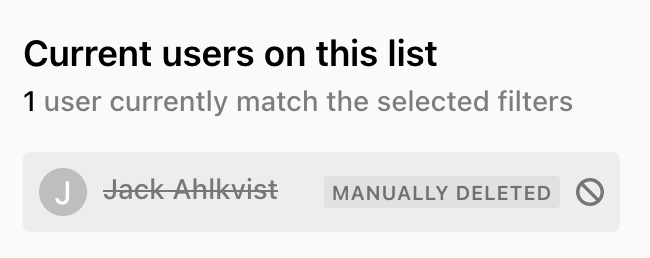
Disconnecting a dynamic list from a learning journey
If you want to disconnect a dynamic list from a learning journey you will be presented with two different options. The option to keep the participants in the learning journey, or to remove them.

If you decide to keep the participants, they will be converted to manually added participants. If you decide to remove the participants, the participants which are unique for the list that is removed will be removed from the learning journey.
Note that if no users are unique for this learning journey, no choice will be presented when you disconnect.
☝ The same choice is presented when deleting a dynamic list. However, the choice can only be made once for all affected learning journeys if the list is deleted while being connected to more than one learning journey.
.png)